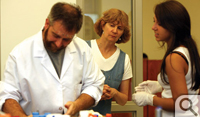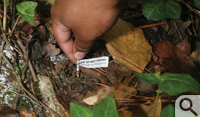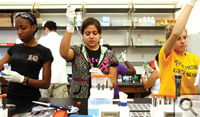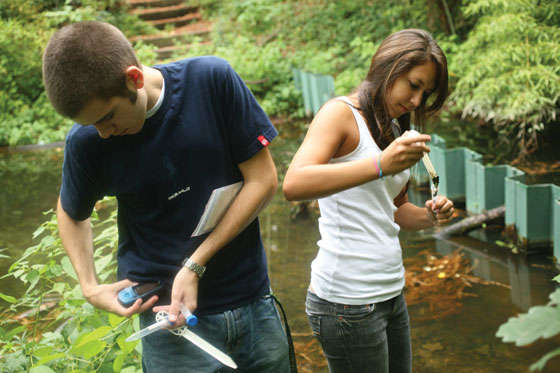Freshman discoveries: It came. Out of the muck of Crim Dell...
A group of William & Mary freshmen has discovered what appears to be a previously unknown form of life.
 The organism, a strain of bacteriophage, was found in the muck of campus landmark Crim Dell, so the students agreed to name it Crim D. The lead scientists in this research-oriented freshman laboratory are Margaret Saha, Mark Forsyth and Kurt Williamson, all members of the biology department. This project is sponsored by the Science Education Alliance of the Howard Hughes Medical Institute. The HHMI initiative organizes groups of freshmen at 12 select colleges into two-semester research courses on the genetics of organisms known as phages or bacteriophages, viruses that infect bacteria.
The organism, a strain of bacteriophage, was found in the muck of campus landmark Crim Dell, so the students agreed to name it Crim D. The lead scientists in this research-oriented freshman laboratory are Margaret Saha, Mark Forsyth and Kurt Williamson, all members of the biology department. This project is sponsored by the Science Education Alliance of the Howard Hughes Medical Institute. The HHMI initiative organizes groups of freshmen at 12 select colleges into two-semester research courses on the genetics of organisms known as phages or bacteriophages, viruses that infect bacteria.
The seminar collected and processed soil samples in the fall semester of 2008, hunting for phages—particularly novel ones. Using state-of-the-art lab techniques, the William & Mary freshmen isolated phages and prepared the DNA of the samples for sequencing—or genetic blueprinting—at Los Alamos National Lab. (See related story to learn why phage study is important.)
Preliminary results from Los Alamos indicate that one of the 10 phage samples sent from William and Mary is a novel strain, previously unrecorded.
“Well, it looks like it’s new,” Williamson said. “But it could still be highly related to something else and not be brand new completely.” The freshman phage seminar began the spring semester by applying various research techniques to verify the genome of Crim D.
“Right now we have what’s known as a draft,” said Forsyth. “We have the finished genome, but we don’t have it quite assembled yet.”
 He explained that the Los Alamos draft contains all the units of the genome in three contiguous parts. The genome contains the order in which the four building blocks of DNA—adenine, thymine, cytosine and guanine—are arranged in couplets known as base pairs, which make up the rungs of the spiral DNA ladder.
He explained that the Los Alamos draft contains all the units of the genome in three contiguous parts. The genome contains the order in which the four building blocks of DNA—adenine, thymine, cytosine and guanine—are arranged in couplets known as base pairs, which make up the rungs of the spiral DNA ladder.
Saha said that preliminary examination has revealed that Crim D is in a family of phages whose genomes have 80 thousand to 90 thousand base pairs. By comparison, the genome of the specific bacterium that Crim D infects consists of four million base pairs, Forsyth explained. The human genome consists of some three billion base pairs.
“One of the first things the students will do is to analyze the data to identify weak spots,” Williamson said. “In other words, there are points in this genome that have been sequenced a fewer number of times. Typically you want ‘8x coverage,’ so each region of the genome is sequenced eight times and at least seven of those eight times need to agree.”
The students will use various techniques to get the genome in proper order and to address Crim D’s weak spots, segments of 300 to 400 base pairs that didn’t make the 8x cut at Los Alamos. The weak segments will be examined using techniques such as the polymerase chain reaction, a DNA amplification tool common in molecular biology labs. All members of the phage seminar are beginning to use state-of-the-art bioinformatics software supplied through HHMI to process the Crim D genome in silico.
“There’s in vivo and in vitro, which everybody knows,” Saha explained. “In silico is becoming much more commonly used to describe things done on a silicon chip in a computer, rather at the lab bench.” Saha, William & Mary’s Chancellor Professor of Biology, said that the sheer amount of data in even small virus-sized genomes makes in silico bioinformatics techniques necessary in today’s research labs.
 “You absolutely need computer computational power to analyze and make sense of these hundreds of thousands of bases and how they fit together or don’t fit together to make up proteins and form genes,” she said. “This can’t be done easily by the human mind, but the computer programs make all the possible combinations and come up with the best series of alignments. This happens in microseconds. Then, of course, we have to curate that and look at it to make sure it makes biological sense. This is the way biology is going in the 21st Century. If you’re not comfortable with computers and the programs and analysis, it’s going to be more and more difficult to do modern biology.”
“You absolutely need computer computational power to analyze and make sense of these hundreds of thousands of bases and how they fit together or don’t fit together to make up proteins and form genes,” she said. “This can’t be done easily by the human mind, but the computer programs make all the possible combinations and come up with the best series of alignments. This happens in microseconds. Then, of course, we have to curate that and look at it to make sure it makes biological sense. This is the way biology is going in the 21st Century. If you’re not comfortable with computers and the programs and analysis, it’s going to be more and more difficult to do modern biology.”
At some point in the semester’s work, the freshmen phage seminar will learn for sure if Crim D is a variant of a known bacteriophage, or if it is a novel phage, previously unknown to science. Either way, their work is important, not just as a learning experience, but as authentic, discovery-oriented research, contributing to scientific knowledge.
“So little is known about bacteriophage, and the diversity is overwhelming,” WIlliamson said. “This could give us a lot of information about selection, evolution, diversity—information that just doesn’t exist right now.” Phages infect bacteria, which makes the viruses of great interest in the biomedical research community as potential alternatives to antibiotics.
Saha said that although she expects the students to prove that Crim D is a new phage, they may not recognize the moment of proof when it arrives.
“The problem with science is that there’s rarely this ‘eureka’ moment,” Saha said. “It’s gradual. By the time you get to what should be your eureka, you realize that there was no one moment where you don’t know, then one where you do know.” 















